As a group, amateur and junior riders often want to over jump their horses purely out of enthusiasm for the sport. Unfortunately, this type of schedule can have adverse effects on our horse's well-being and longevity. How do you keep your horse fresh and sound to withstand the test of time? To answer this question, I referred to one of my respected go-to professionals, Jennifer Berol-Bliss, the owner of Harris Hill Farm. Jennifer exclusively specializes in developing high quality show hunters and has garnered many prestigious awards throughout her young career.
In the article below, Jennifer outlines the program she uses for her horses from scheduling at home and at shows to health care and maintenance. This is the plan I now use, including her exchange of jumps for ground rails on some jumping days to preserve your horse's legs. With ground rails, you can practice adjustability, cadence, tracking and in my case, distances! Thanks to Jennifer's introduction to StableSecretary.com, I have also have switched to managing all of my horse's medical, maintenance and ID documentation to this extremely simple to use and reasonably priced smart phone app and desktop software. Developed by horse show professionals, this program has assisted me in better managing all of my horse's records and not being caught off guard for missing a shoeing appointment, locating digital x-rays, scheduling body work or locating Sazarek's USEF number.
The copy for the article below called "Developing Champions for Life" was originally featured last June in America's Premier Horse Show Magazine, "The Plaid Horse." I find it is extremely timely as many of us are using the holiday break to build our schedules for next year, including the winter circuits. There are many tips to glean from Jennifer's tried and true and program and we wish you the best of luck in all of your equestrian endevours in 2016!
Salut!

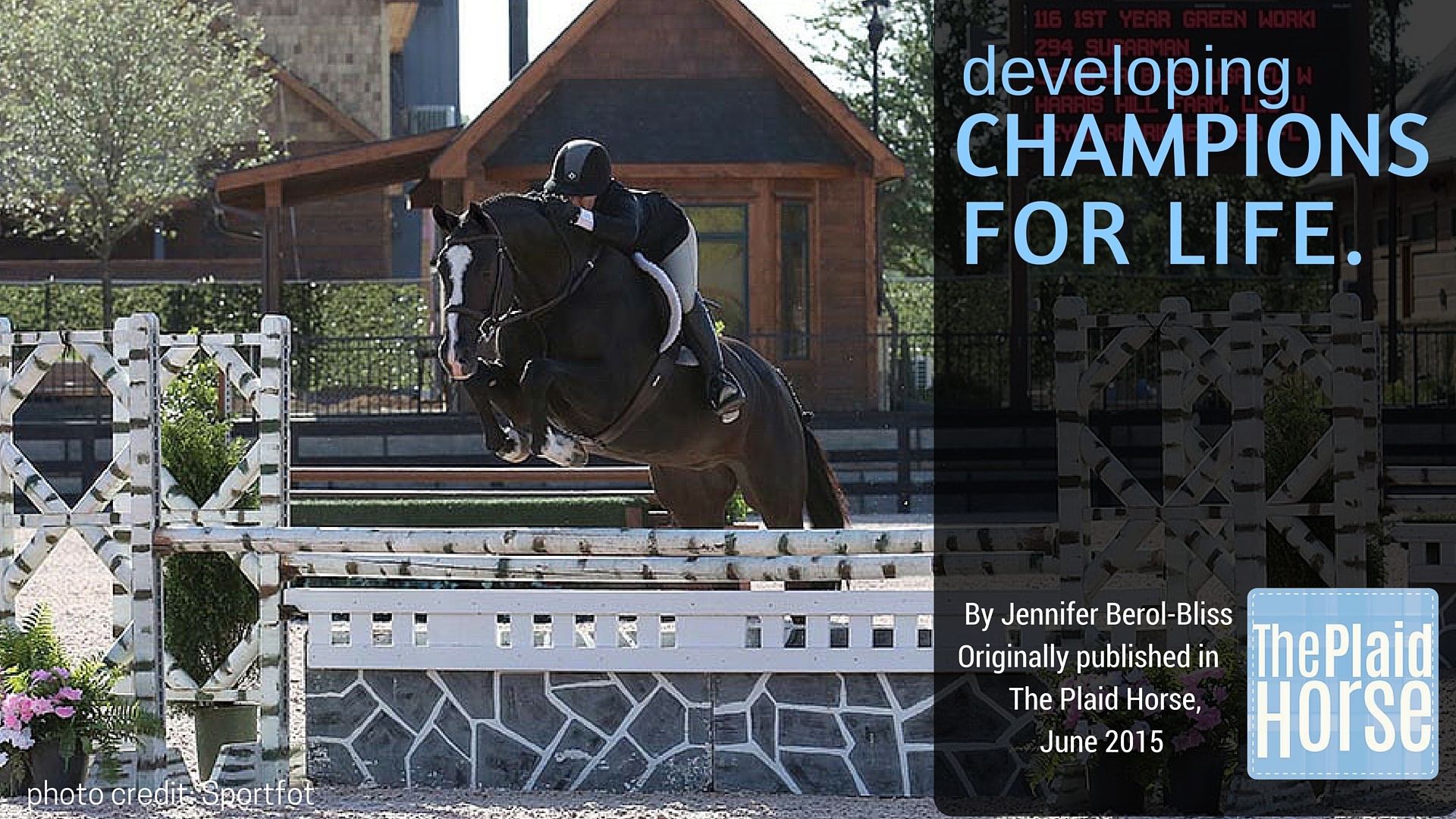
ADMIRATION
I have always admired horse and rider combinations that have been able to withstand the test of time in the show ring and continue to win year after year. These tried and true partnerships are inspiring in many ways. Over the years I have become increasingly aware and appreciative of the care and management that goes into preserving the longevity of top show hunters. I have integrated many of the teachings I have learned to develop a program for my own business, Harris Hill Farm, that is as much about training as it is about proper care and maintenance.
WORK SCHEDULE AT HOME
As a general rule, the typical week for each horse in our program starts gradually, increases in intensity and then tapers again. My ideal schedule:
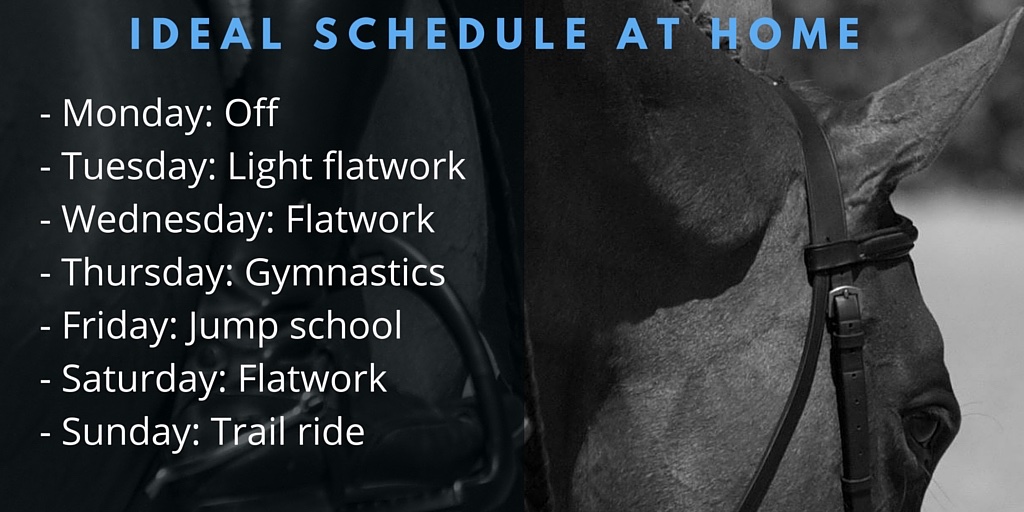 If a horse is not scheduled to show in the near future, I often replace the jump school with ground rail or cavaletti work. I find that this substitution allows me to practice adjustments and rideability without subjecting the horse to physical wear and tear resulting from the rigors of repetitive jumping.
If a horse is not scheduled to show in the near future, I often replace the jump school with ground rail or cavaletti work. I find that this substitution allows me to practice adjustments and rideability without subjecting the horse to physical wear and tear resulting from the rigors of repetitive jumping.
Our program is specifically structured to encourage the horses to move around during the day. Each horse starts its morning with a turnout, followed up with its training session, and ending each afternoon with a hand walk. When possible, we replace the hand walk with treadmill exercise. I am a huge proponent of this activity because it provides a physical workout without mentally drilling the horses. Our treadmill program alternates walking on the flat with slight incline work every other day
A consistent routine at home is very important. This is the homework that ensures each Harris Hill Farm hunter arrives fit and completely prepared for the test of the horse show.
HORSE SHOWS SCHEDULING AND ROUTINES
I like to schedule horse shows so that we compete for two or three weeks and follow with two or three weeks off. This timetable provides enough consistency for the horses to hit a rhythm and become seasoned, yet provides the necessary time to rest and unwind to stay fresh. By following this schedule, the horses are ready to gear up again and we can also work on any issues that may have arisen at the previous show.
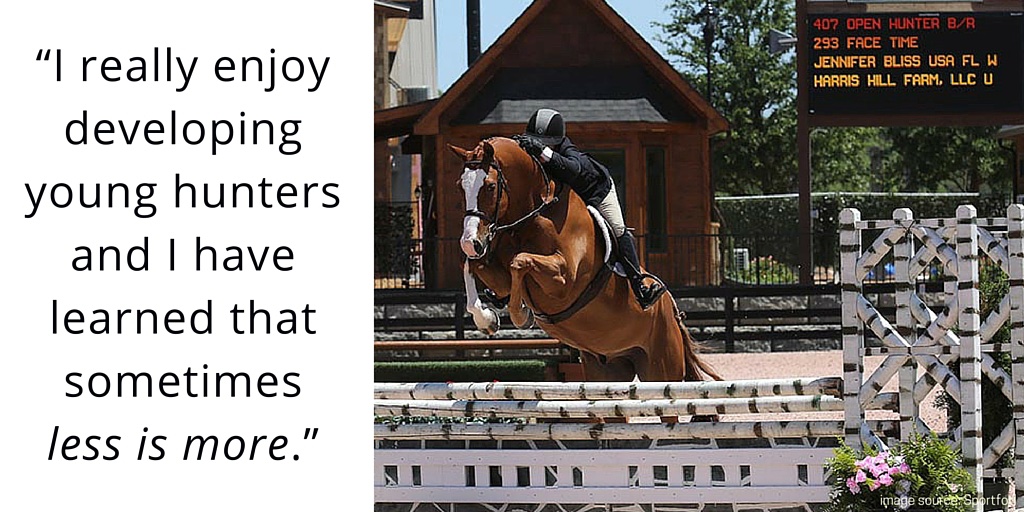
I really enjoy developing young hunters and I have learned that sometimes less is more. Green horses need to spend time in the lower divisions to become comfortable both in the ring and with the horse show environment. I try to keep these experiences to a minimum and use them as markers to determine where the horse is at in its training and what we need to practice at home to improve. Jumping too many small fences in the show ring can take away their enthusiasm and "try”. I have therefore learned to not overly protect the young ones. Similar to the progression of our own learning process; horses grow from being challenged in a constructive way.
THERAPIES, VET CARE, AND ORGANIZATION
My horses work hard for me and it is important that I reciprocate by helping each one feel their absolute best. We regularly use ice boots, magnetic blankets, and a Theraplate machine and also maintain a schedule for bi-monthly bodywork that includes chiropractic and massage. Every six months our veterinarian completes a thorough examination to ensure that each horse is completely healthy and comfortable, regardless if we have noticed any abnormalities in their general condition.
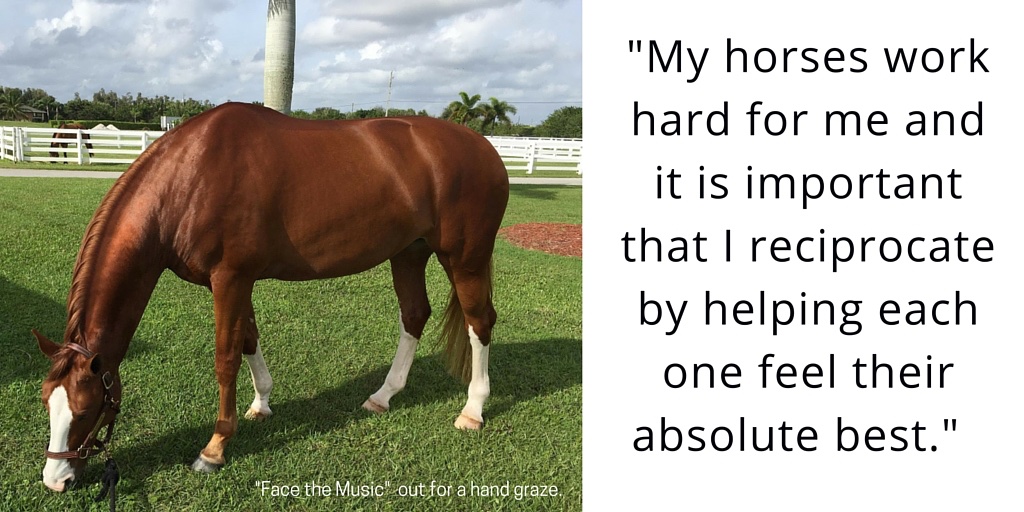
I am adamant about maintaining meticulous records of services performed on every animal at our farm. Not only does this routine assist with scheduling, but I can also reference the records to track trends in behavior and/or way of going. I prefer to use a software program called “Stable Secretary”.” It is both savvy for the modern show horse and user friendly for the sometimes technologically challenged, like myself!
GRATIFICATION RECEIVED THROUGH REPETITION
I think of my horses like family. Some of my happiest moments occur during night check. This is when I enjoy feeding them treats and listen to them munch hay in total contentment while I reflect on the day and make plans for the next.

I strive to help my horses achieve success and have long careers, whether with me or after they have ultimately progressed to new owners. Creating a solid routine is critical to achieving these goals, as does being open-minded to new ideas. I am always interested in learning how others run their barns and care for their horses. Often, a little tweak from a bit of knowledge can have a big impact on a program and ultimately create show horses that enjoy their job for many years.

ABOUT
Jennifer Bliss/Harris Hill Farm
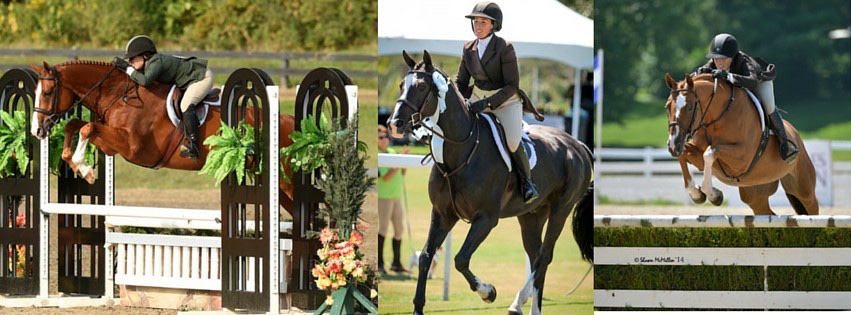
IMAGES: From L to R: (1) Harris Hill Farm mare, Face the Music, started her partnership late show season with Jennifer and immedietly garnered top placings including a top ten finish in the Stal Hendrix Pre-Green Futurity Championship in Saugerties (photo credit: The Chronicle of the Horse 2015), (2) Jennifer piloted her Sugarman to a top 10 finish at the prestigious $50,000 USHJA International Hunter Derby at 2015 WEF (photo credit: Erin Gilmore 2015), Jennifer rode her beloved Poker Face, to a top ten finish in the USHJA International Hunter Derby Championships in Lexington, Kentucky (photo credit: Shawn McMillan 2014)
Jennifer grew up as an active competitor on the “A” horse show circuit and enjoyed great success as a junior, winning such major accolades as Pony Final Championships, Horse of the Year awards, and top ten placings at the indoor equitation finals. She rode under the tutelage of equitation expert Missy Clark, in addition to catch-riding pony and junior hunters for such top industry professionals as Scott Stewart, Tim Goguen, Tom Wright and Charlie Weaver.
Jennifer opened Harris Hill Farm, LLC in 2008, and in conjunction with fiancé and barn manager, Deywi Rodriguez, has established herself as a successful professional rider and trainer. In 2014, Jennifer was the champion for the both the WCHR Northeast and National Developing Pro Championship divisions and also had a top ten finish in the USHJA International Hunter Derby Finals.
Harris Hill Farm is based out of Wellington, Florida and specializes in finding, developing, and showing high quality young hunters.
For more information about Jennifer Bliss/Harris Hill Farm, please visit www.HarrisHillFarmllc.com

To read the original article as published in The Plaid Horse, CLICK HERE.


0 Comments